Cloud Computing: Exploring Benefits, Drawbacks, and Service Models
VerifiedAdded on 2020/04/07
|16
|3125
|125
Report
AI Summary
This report provides a comprehensive analysis of cloud computing, examining its benefits and drawbacks for both businesses and individual users. It begins with an introduction to cloud computing, defining its key characteristics and highlighting its growing importance in modern IT infrastructure. The report then outlines the project objective, scope, and reviews existing literature on various cloud computing models, including private, public, hybrid, community, distributed, inter-cloud, and multi-cloud. It formulates research questions and hypotheses to guide the investigation. The methodology section details a deductive research approach employing both primary and secondary data collection methods, including surveys and literature reviews. The report specifies the sampling techniques, questionnaire design, and data analysis process, which involves statistical measures and graphical representations. The research identifies and analyzes the key research variables, including cloud service types, benefits, and drawbacks. The conclusion summarizes the findings and their implications. Finally, the report includes a reference list of the sources used.

Running head: CLOUD COMPUTING AND ITS BENEFITS AND DRAWBACKS
Cloud Computing and Its Benefits and Drawbacks
Name of Student:
Name of University:
Author’s Note:
Cloud Computing and Its Benefits and Drawbacks
Name of Student:
Name of University:
Author’s Note:
Paraphrase This Document
Need a fresh take? Get an instant paraphrase of this document with our AI Paraphraser
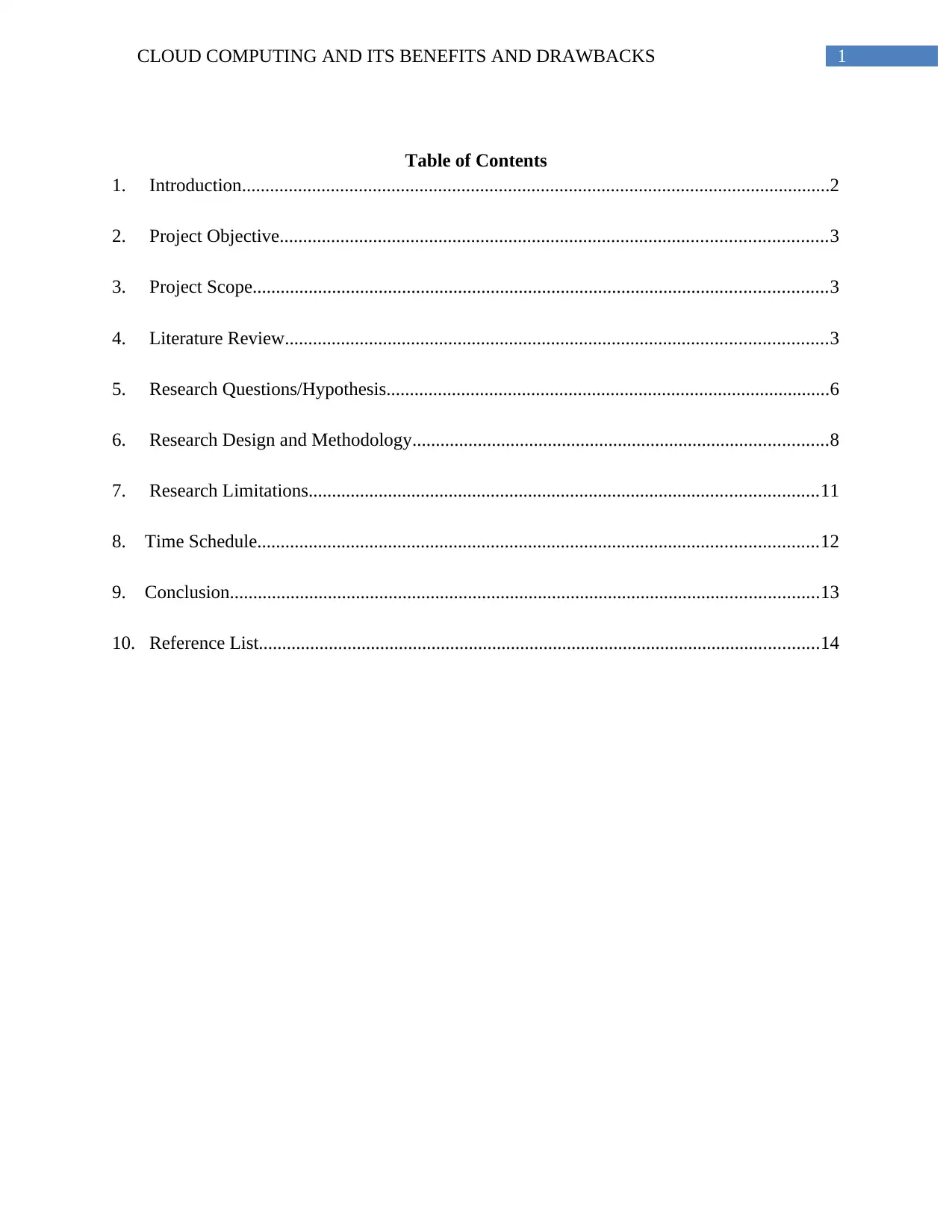
1CLOUD COMPUTING AND ITS BENEFITS AND DRAWBACKS
Table of Contents
1. Introduction..............................................................................................................................2
2. Project Objective.....................................................................................................................3
3. Project Scope...........................................................................................................................3
4. Literature Review....................................................................................................................3
5. Research Questions/Hypothesis...............................................................................................6
6. Research Design and Methodology.........................................................................................8
7. Research Limitations.............................................................................................................11
8. Time Schedule........................................................................................................................12
9. Conclusion..............................................................................................................................13
10. Reference List........................................................................................................................14
Table of Contents
1. Introduction..............................................................................................................................2
2. Project Objective.....................................................................................................................3
3. Project Scope...........................................................................................................................3
4. Literature Review....................................................................................................................3
5. Research Questions/Hypothesis...............................................................................................6
6. Research Design and Methodology.........................................................................................8
7. Research Limitations.............................................................................................................11
8. Time Schedule........................................................................................................................12
9. Conclusion..............................................................................................................................13
10. Reference List........................................................................................................................14
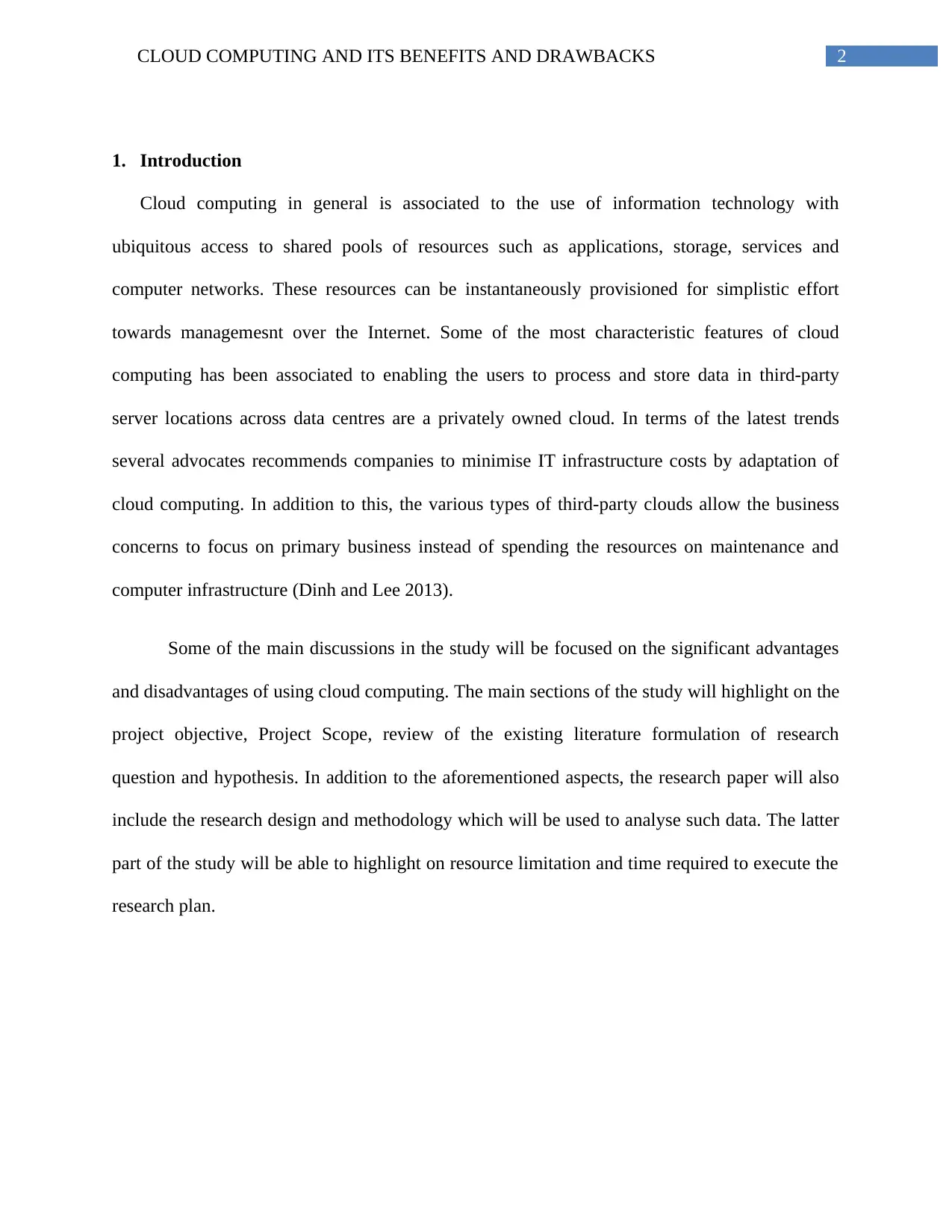
2CLOUD COMPUTING AND ITS BENEFITS AND DRAWBACKS
1. Introduction
Cloud computing in general is associated to the use of information technology with
ubiquitous access to shared pools of resources such as applications, storage, services and
computer networks. These resources can be instantaneously provisioned for simplistic effort
towards managemesnt over the Internet. Some of the most characteristic features of cloud
computing has been associated to enabling the users to process and store data in third-party
server locations across data centres are a privately owned cloud. In terms of the latest trends
several advocates recommends companies to minimise IT infrastructure costs by adaptation of
cloud computing. In addition to this, the various types of third-party clouds allow the business
concerns to focus on primary business instead of spending the resources on maintenance and
computer infrastructure (Dinh and Lee 2013).
Some of the main discussions in the study will be focused on the significant advantages
and disadvantages of using cloud computing. The main sections of the study will highlight on the
project objective, Project Scope, review of the existing literature formulation of research
question and hypothesis. In addition to the aforementioned aspects, the research paper will also
include the research design and methodology which will be used to analyse such data. The latter
part of the study will be able to highlight on resource limitation and time required to execute the
research plan.
1. Introduction
Cloud computing in general is associated to the use of information technology with
ubiquitous access to shared pools of resources such as applications, storage, services and
computer networks. These resources can be instantaneously provisioned for simplistic effort
towards managemesnt over the Internet. Some of the most characteristic features of cloud
computing has been associated to enabling the users to process and store data in third-party
server locations across data centres are a privately owned cloud. In terms of the latest trends
several advocates recommends companies to minimise IT infrastructure costs by adaptation of
cloud computing. In addition to this, the various types of third-party clouds allow the business
concerns to focus on primary business instead of spending the resources on maintenance and
computer infrastructure (Dinh and Lee 2013).
Some of the main discussions in the study will be focused on the significant advantages
and disadvantages of using cloud computing. The main sections of the study will highlight on the
project objective, Project Scope, review of the existing literature formulation of research
question and hypothesis. In addition to the aforementioned aspects, the research paper will also
include the research design and methodology which will be used to analyse such data. The latter
part of the study will be able to highlight on resource limitation and time required to execute the
research plan.
⊘ This is a preview!⊘
Do you want full access?
Subscribe today to unlock all pages.

Trusted by 1+ million students worldwide
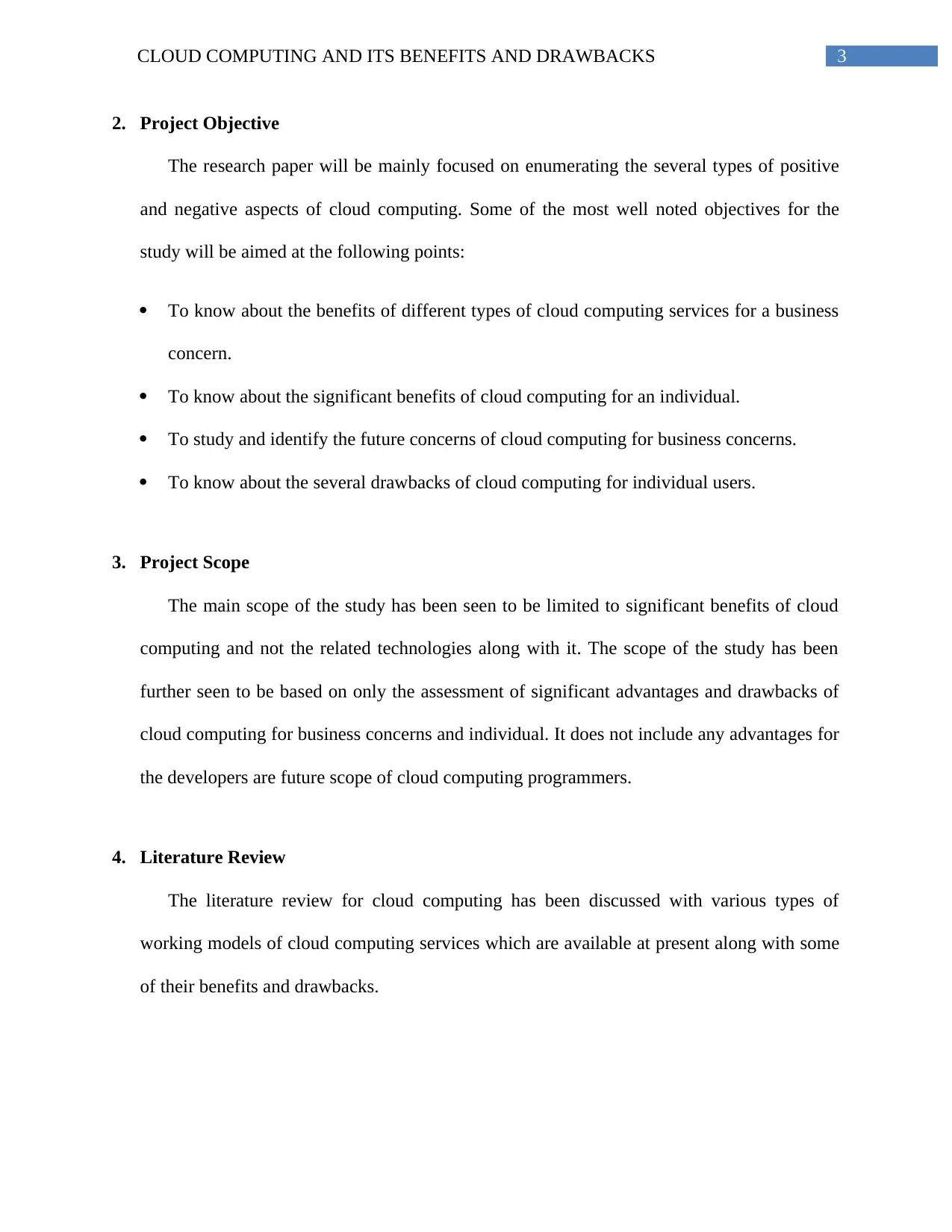
3CLOUD COMPUTING AND ITS BENEFITS AND DRAWBACKS
2. Project Objective
The research paper will be mainly focused on enumerating the several types of positive
and negative aspects of cloud computing. Some of the most well noted objectives for the
study will be aimed at the following points:
To know about the benefits of different types of cloud computing services for a business
concern.
To know about the significant benefits of cloud computing for an individual.
To study and identify the future concerns of cloud computing for business concerns.
To know about the several drawbacks of cloud computing for individual users.
3. Project Scope
The main scope of the study has been seen to be limited to significant benefits of cloud
computing and not the related technologies along with it. The scope of the study has been
further seen to be based on only the assessment of significant advantages and drawbacks of
cloud computing for business concerns and individual. It does not include any advantages for
the developers are future scope of cloud computing programmers.
4. Literature Review
The literature review for cloud computing has been discussed with various types of
working models of cloud computing services which are available at present along with some
of their benefits and drawbacks.
2. Project Objective
The research paper will be mainly focused on enumerating the several types of positive
and negative aspects of cloud computing. Some of the most well noted objectives for the
study will be aimed at the following points:
To know about the benefits of different types of cloud computing services for a business
concern.
To know about the significant benefits of cloud computing for an individual.
To study and identify the future concerns of cloud computing for business concerns.
To know about the several drawbacks of cloud computing for individual users.
3. Project Scope
The main scope of the study has been seen to be limited to significant benefits of cloud
computing and not the related technologies along with it. The scope of the study has been
further seen to be based on only the assessment of significant advantages and drawbacks of
cloud computing for business concerns and individual. It does not include any advantages for
the developers are future scope of cloud computing programmers.
4. Literature Review
The literature review for cloud computing has been discussed with various types of
working models of cloud computing services which are available at present along with some
of their benefits and drawbacks.
Paraphrase This Document
Need a fresh take? Get an instant paraphrase of this document with our AI Paraphraser

4CLOUD COMPUTING AND ITS BENEFITS AND DRAWBACKS
Private cloud
This type of cloud infrastructure relies on a single organisation and it can be managed by
both third-party and internally and at the same time hosted either externally or internally. This is
also based on self run data centres which are capital intensive in nature. The most distinctive
features of private cloud are seen with having a dedicated hardware, physical footprint and
environmental controls (Yigit, Gungor and Baktir 2014).
Public cloud
The most characteristic features of public cloud is seen with the use of services which are
provided openly for public use. The different types of public cloud services are designed to be
free of cost and there is very little difference between the architecture of public and private
cloud. The most distinguished feature of private and public cloud is seen with the high aspect of
security consideration for resources application and storage. These cloud are responsible for
bringing the data forward to the audience then the communication gets affected in a non-trusted
network. In general, the public cloud service providers such as “Google”, “Amazon Web
services (AWS)” and “Microsoft” operate with a dedicated infrastructure for data centre which
can be accessed via Internet (Fehling et al. 2014).
Hybrid cloud
This special type of cloud computing services associated with combination of two or
more clouds such as public, community or private. The service of this is further seen to remain
distinct and offer multiple deployment models with unique benefits. The hybrid cloud service is
often seen to cause the isolation of separate cloud computing entities and bring together the
categories of the same to a single platform. The services of hybrid cloud adaptation depend on
Private cloud
This type of cloud infrastructure relies on a single organisation and it can be managed by
both third-party and internally and at the same time hosted either externally or internally. This is
also based on self run data centres which are capital intensive in nature. The most distinctive
features of private cloud are seen with having a dedicated hardware, physical footprint and
environmental controls (Yigit, Gungor and Baktir 2014).
Public cloud
The most characteristic features of public cloud is seen with the use of services which are
provided openly for public use. The different types of public cloud services are designed to be
free of cost and there is very little difference between the architecture of public and private
cloud. The most distinguished feature of private and public cloud is seen with the high aspect of
security consideration for resources application and storage. These cloud are responsible for
bringing the data forward to the audience then the communication gets affected in a non-trusted
network. In general, the public cloud service providers such as “Google”, “Amazon Web
services (AWS)” and “Microsoft” operate with a dedicated infrastructure for data centre which
can be accessed via Internet (Fehling et al. 2014).
Hybrid cloud
This special type of cloud computing services associated with combination of two or
more clouds such as public, community or private. The service of this is further seen to remain
distinct and offer multiple deployment models with unique benefits. The hybrid cloud service is
often seen to cause the isolation of separate cloud computing entities and bring together the
categories of the same to a single platform. The services of hybrid cloud adaptation depend on
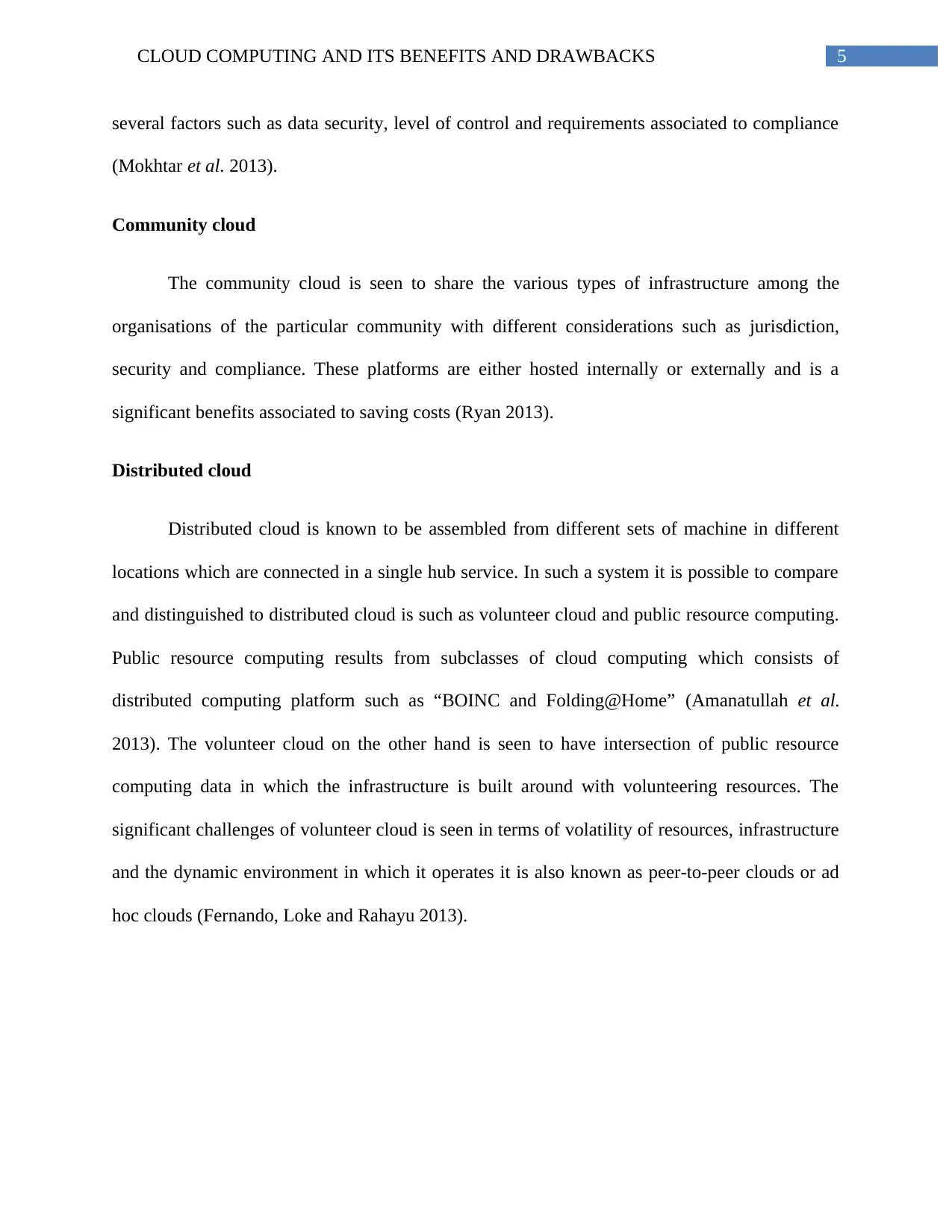
5CLOUD COMPUTING AND ITS BENEFITS AND DRAWBACKS
several factors such as data security, level of control and requirements associated to compliance
(Mokhtar et al. 2013).
Community cloud
The community cloud is seen to share the various types of infrastructure among the
organisations of the particular community with different considerations such as jurisdiction,
security and compliance. These platforms are either hosted internally or externally and is a
significant benefits associated to saving costs (Ryan 2013).
Distributed cloud
Distributed cloud is known to be assembled from different sets of machine in different
locations which are connected in a single hub service. In such a system it is possible to compare
and distinguished to distributed cloud is such as volunteer cloud and public resource computing.
Public resource computing results from subclasses of cloud computing which consists of
distributed computing platform such as “BOINC and Folding@Home” (Amanatullah et al.
2013). The volunteer cloud on the other hand is seen to have intersection of public resource
computing data in which the infrastructure is built around with volunteering resources. The
significant challenges of volunteer cloud is seen in terms of volatility of resources, infrastructure
and the dynamic environment in which it operates it is also known as peer-to-peer clouds or ad
hoc clouds (Fernando, Loke and Rahayu 2013).
several factors such as data security, level of control and requirements associated to compliance
(Mokhtar et al. 2013).
Community cloud
The community cloud is seen to share the various types of infrastructure among the
organisations of the particular community with different considerations such as jurisdiction,
security and compliance. These platforms are either hosted internally or externally and is a
significant benefits associated to saving costs (Ryan 2013).
Distributed cloud
Distributed cloud is known to be assembled from different sets of machine in different
locations which are connected in a single hub service. In such a system it is possible to compare
and distinguished to distributed cloud is such as volunteer cloud and public resource computing.
Public resource computing results from subclasses of cloud computing which consists of
distributed computing platform such as “BOINC and Folding@Home” (Amanatullah et al.
2013). The volunteer cloud on the other hand is seen to have intersection of public resource
computing data in which the infrastructure is built around with volunteering resources. The
significant challenges of volunteer cloud is seen in terms of volatility of resources, infrastructure
and the dynamic environment in which it operates it is also known as peer-to-peer clouds or ad
hoc clouds (Fernando, Loke and Rahayu 2013).
⊘ This is a preview!⊘
Do you want full access?
Subscribe today to unlock all pages.

Trusted by 1+ million students worldwide

6CLOUD COMPUTING AND ITS BENEFITS AND DRAWBACKS
Inter cloud
Inter cloud is such a feature which encompasses "cloud of clouds" which is often
identified as an extension of “network of networks “and focus on the interoperability among the
service providers and consumers (Ali, Khan and Vasilakos 2015).
Multicloud
This type of concept of cloud computing services is often composed of a single
heterogeneous architecture which is often choose to reduce the reliance on vendor’s thereby
increasing the choices, mitigate disaster among several other benefits. The main differentiating
feature from a hybrid cloud and a multi-cloud seen in terms of the multiple cloud services of
multi-cloud rather than different deployment modes and hybrid cloud computing services such as
literacy, public and private (Bumpus 2013).
5. Research Questions/Hypothesis
The research questions as being segregated into two sections namely primary question and
secondary questions.
Primary Question
What are the benefits and drawbacks of cloud computing on individuals and business entities?
Secondary Questions
Inter cloud
Inter cloud is such a feature which encompasses "cloud of clouds" which is often
identified as an extension of “network of networks “and focus on the interoperability among the
service providers and consumers (Ali, Khan and Vasilakos 2015).
Multicloud
This type of concept of cloud computing services is often composed of a single
heterogeneous architecture which is often choose to reduce the reliance on vendor’s thereby
increasing the choices, mitigate disaster among several other benefits. The main differentiating
feature from a hybrid cloud and a multi-cloud seen in terms of the multiple cloud services of
multi-cloud rather than different deployment modes and hybrid cloud computing services such as
literacy, public and private (Bumpus 2013).
5. Research Questions/Hypothesis
The research questions as being segregated into two sections namely primary question and
secondary questions.
Primary Question
What are the benefits and drawbacks of cloud computing on individuals and business entities?
Secondary Questions
Paraphrase This Document
Need a fresh take? Get an instant paraphrase of this document with our AI Paraphraser
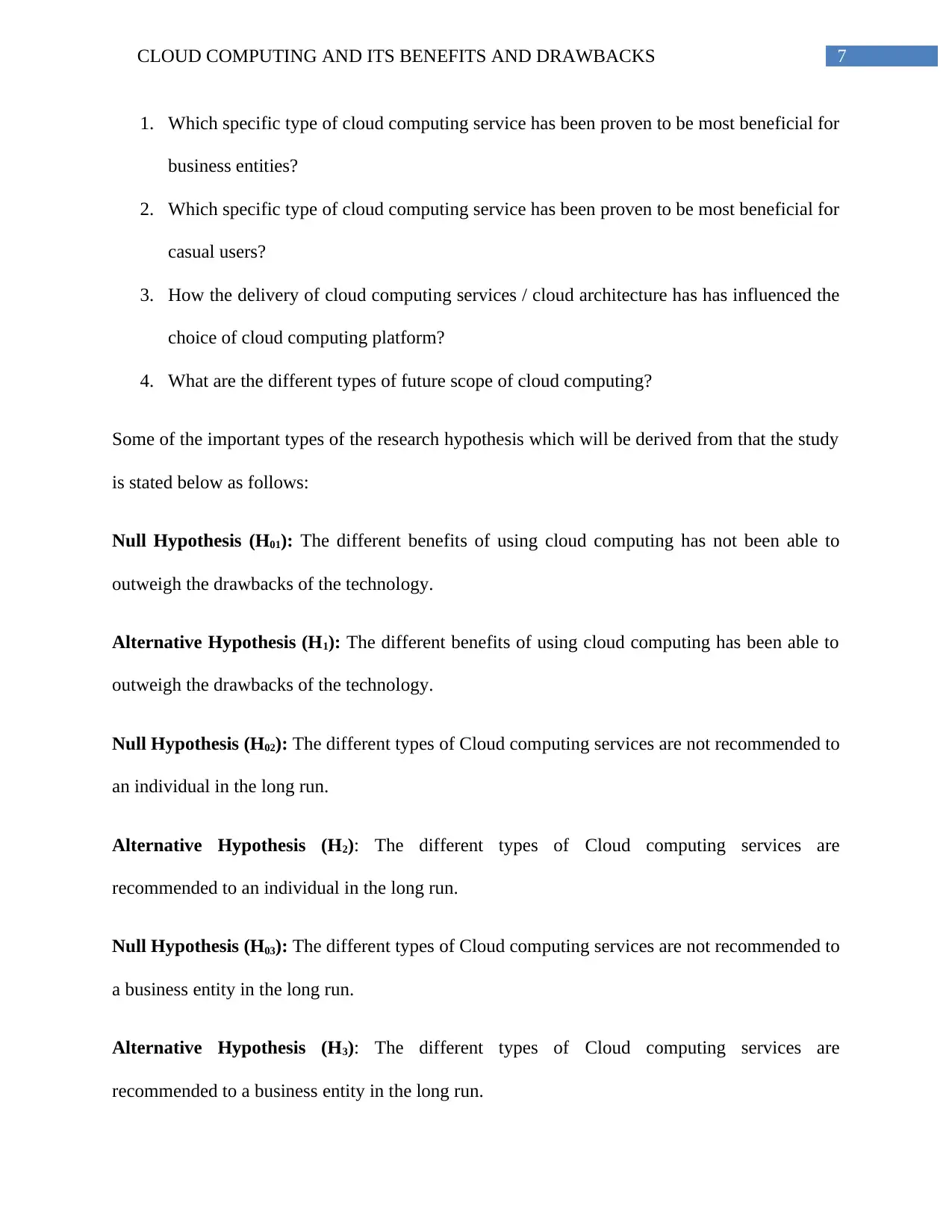
7CLOUD COMPUTING AND ITS BENEFITS AND DRAWBACKS
1. Which specific type of cloud computing service has been proven to be most beneficial for
business entities?
2. Which specific type of cloud computing service has been proven to be most beneficial for
casual users?
3. How the delivery of cloud computing services / cloud architecture has has influenced the
choice of cloud computing platform?
4. What are the different types of future scope of cloud computing?
Some of the important types of the research hypothesis which will be derived from that the study
is stated below as follows:
Null Hypothesis (H01): The different benefits of using cloud computing has not been able to
outweigh the drawbacks of the technology.
Alternative Hypothesis (H1): The different benefits of using cloud computing has been able to
outweigh the drawbacks of the technology.
Null Hypothesis (H02): The different types of Cloud computing services are not recommended to
an individual in the long run.
Alternative Hypothesis (H2): The different types of Cloud computing services are
recommended to an individual in the long run.
Null Hypothesis (H03): The different types of Cloud computing services are not recommended to
a business entity in the long run.
Alternative Hypothesis (H3): The different types of Cloud computing services are
recommended to a business entity in the long run.
1. Which specific type of cloud computing service has been proven to be most beneficial for
business entities?
2. Which specific type of cloud computing service has been proven to be most beneficial for
casual users?
3. How the delivery of cloud computing services / cloud architecture has has influenced the
choice of cloud computing platform?
4. What are the different types of future scope of cloud computing?
Some of the important types of the research hypothesis which will be derived from that the study
is stated below as follows:
Null Hypothesis (H01): The different benefits of using cloud computing has not been able to
outweigh the drawbacks of the technology.
Alternative Hypothesis (H1): The different benefits of using cloud computing has been able to
outweigh the drawbacks of the technology.
Null Hypothesis (H02): The different types of Cloud computing services are not recommended to
an individual in the long run.
Alternative Hypothesis (H2): The different types of Cloud computing services are
recommended to an individual in the long run.
Null Hypothesis (H03): The different types of Cloud computing services are not recommended to
a business entity in the long run.
Alternative Hypothesis (H3): The different types of Cloud computing services are
recommended to a business entity in the long run.
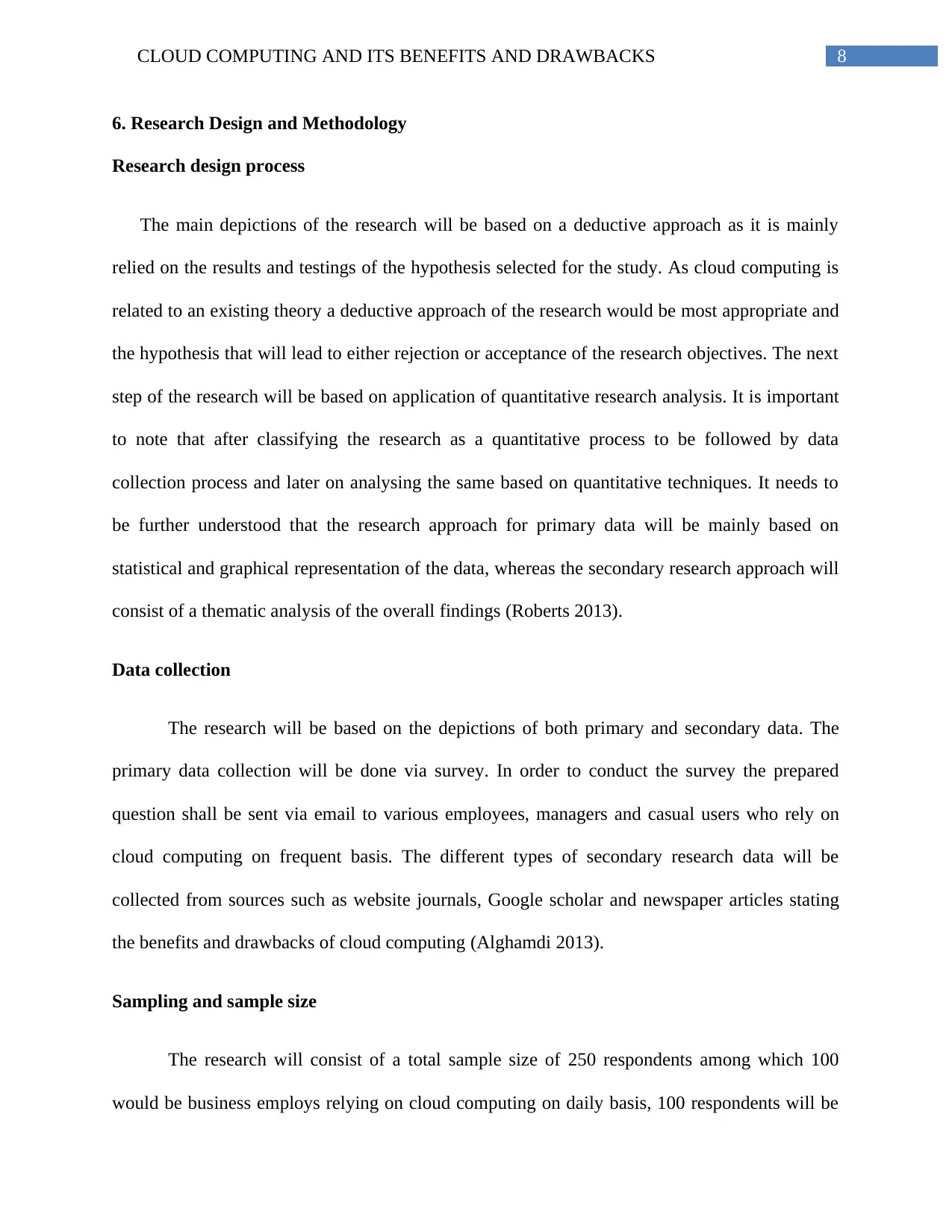
8CLOUD COMPUTING AND ITS BENEFITS AND DRAWBACKS
6. Research Design and Methodology
Research design process
The main depictions of the research will be based on a deductive approach as it is mainly
relied on the results and testings of the hypothesis selected for the study. As cloud computing is
related to an existing theory a deductive approach of the research would be most appropriate and
the hypothesis that will lead to either rejection or acceptance of the research objectives. The next
step of the research will be based on application of quantitative research analysis. It is important
to note that after classifying the research as a quantitative process to be followed by data
collection process and later on analysing the same based on quantitative techniques. It needs to
be further understood that the research approach for primary data will be mainly based on
statistical and graphical representation of the data, whereas the secondary research approach will
consist of a thematic analysis of the overall findings (Roberts 2013).
Data collection
The research will be based on the depictions of both primary and secondary data. The
primary data collection will be done via survey. In order to conduct the survey the prepared
question shall be sent via email to various employees, managers and casual users who rely on
cloud computing on frequent basis. The different types of secondary research data will be
collected from sources such as website journals, Google scholar and newspaper articles stating
the benefits and drawbacks of cloud computing (Alghamdi 2013).
Sampling and sample size
The research will consist of a total sample size of 250 respondents among which 100
would be business employs relying on cloud computing on daily basis, 100 respondents will be
6. Research Design and Methodology
Research design process
The main depictions of the research will be based on a deductive approach as it is mainly
relied on the results and testings of the hypothesis selected for the study. As cloud computing is
related to an existing theory a deductive approach of the research would be most appropriate and
the hypothesis that will lead to either rejection or acceptance of the research objectives. The next
step of the research will be based on application of quantitative research analysis. It is important
to note that after classifying the research as a quantitative process to be followed by data
collection process and later on analysing the same based on quantitative techniques. It needs to
be further understood that the research approach for primary data will be mainly based on
statistical and graphical representation of the data, whereas the secondary research approach will
consist of a thematic analysis of the overall findings (Roberts 2013).
Data collection
The research will be based on the depictions of both primary and secondary data. The
primary data collection will be done via survey. In order to conduct the survey the prepared
question shall be sent via email to various employees, managers and casual users who rely on
cloud computing on frequent basis. The different types of secondary research data will be
collected from sources such as website journals, Google scholar and newspaper articles stating
the benefits and drawbacks of cloud computing (Alghamdi 2013).
Sampling and sample size
The research will consist of a total sample size of 250 respondents among which 100
would be business employs relying on cloud computing on daily basis, 100 respondents will be
⊘ This is a preview!⊘
Do you want full access?
Subscribe today to unlock all pages.

Trusted by 1+ million students worldwide

9CLOUD COMPUTING AND ITS BENEFITS AND DRAWBACKS
casual users who frequently obtain the third-party services of cloud computing and 50
respondents will be chosen from managers of business entities. The main form of sampling
technique has been defending form of simple random sampling as this will give equal
opportunity with the respondents for placing their opinion on the questions asked in the survey.
The selection of simple random sampling will also ensure that the response collected from the
population is not biased in any form (Bourke 2014).
Questionnaire design
In order to get the most reliable data out of the questionnaire it will be prepared based on
the measurement scale of Cardinal, nominal, ordinal and ratio measurements. The question is
based on nominal scale of measurement will involve several types of general and demographic
questions such as respondent’s place of origin, gender, type of cloud computing service opted for
an and organisation they are working for if applicable (Rajasekar and Philominathan 2013). The
data from some of the ordinal scale of measurement will be taken from assigning likert scale
measurements such as “5” - “strongly agree”, “4”- “moderately agreeing”, option “3” - giving a
“neutral” opinion, option for “2” -“disagreeing” and option “1” - “completely disagreeing”. The
data based on the Cardinal and interval measurement will involve questions such as reliability of
cloud computing services based on their frequency of usage (Ranjit 2014).
Data analysis Process
The data analysis process will be done by use of statistical measures such as application
of descriptive statistics and measures of dispersion on the data collected. In order to test the
hypothesis set for the study regression method will be used which will be able to address whether
the hypothesis should be accepted or rejected based on the identified research variables. The data
casual users who frequently obtain the third-party services of cloud computing and 50
respondents will be chosen from managers of business entities. The main form of sampling
technique has been defending form of simple random sampling as this will give equal
opportunity with the respondents for placing their opinion on the questions asked in the survey.
The selection of simple random sampling will also ensure that the response collected from the
population is not biased in any form (Bourke 2014).
Questionnaire design
In order to get the most reliable data out of the questionnaire it will be prepared based on
the measurement scale of Cardinal, nominal, ordinal and ratio measurements. The question is
based on nominal scale of measurement will involve several types of general and demographic
questions such as respondent’s place of origin, gender, type of cloud computing service opted for
an and organisation they are working for if applicable (Rajasekar and Philominathan 2013). The
data from some of the ordinal scale of measurement will be taken from assigning likert scale
measurements such as “5” - “strongly agree”, “4”- “moderately agreeing”, option “3” - giving a
“neutral” opinion, option for “2” -“disagreeing” and option “1” - “completely disagreeing”. The
data based on the Cardinal and interval measurement will involve questions such as reliability of
cloud computing services based on their frequency of usage (Ranjit 2014).
Data analysis Process
The data analysis process will be done by use of statistical measures such as application
of descriptive statistics and measures of dispersion on the data collected. In order to test the
hypothesis set for the study regression method will be used which will be able to address whether
the hypothesis should be accepted or rejected based on the identified research variables. The data
Paraphrase This Document
Need a fresh take? Get an instant paraphrase of this document with our AI Paraphraser

10CLOUD COMPUTING AND ITS BENEFITS AND DRAWBACKS
analysis will further include the use of bar charts and pie charts for a visually aesthetic
representation of the assessments (Rowland, Hub and Services 2013).
Research variables
Dependent Variable 1
Cloud computing service having the best value
Independent Variable 1
Private cloud
Public cloud
Hybrid cloud
Community cloud
Distributed cloud
Inter cloud
Multicloud
Dependent Variable 2
Most noted benefit of cloud computing
Independent Variable 2
Cost Efficient technology
Unlimited storage capacity
Easy Backup and Recovery
Software integration
analysis will further include the use of bar charts and pie charts for a visually aesthetic
representation of the assessments (Rowland, Hub and Services 2013).
Research variables
Dependent Variable 1
Cloud computing service having the best value
Independent Variable 1
Private cloud
Public cloud
Hybrid cloud
Community cloud
Distributed cloud
Inter cloud
Multicloud
Dependent Variable 2
Most noted benefit of cloud computing
Independent Variable 2
Cost Efficient technology
Unlimited storage capacity
Easy Backup and Recovery
Software integration
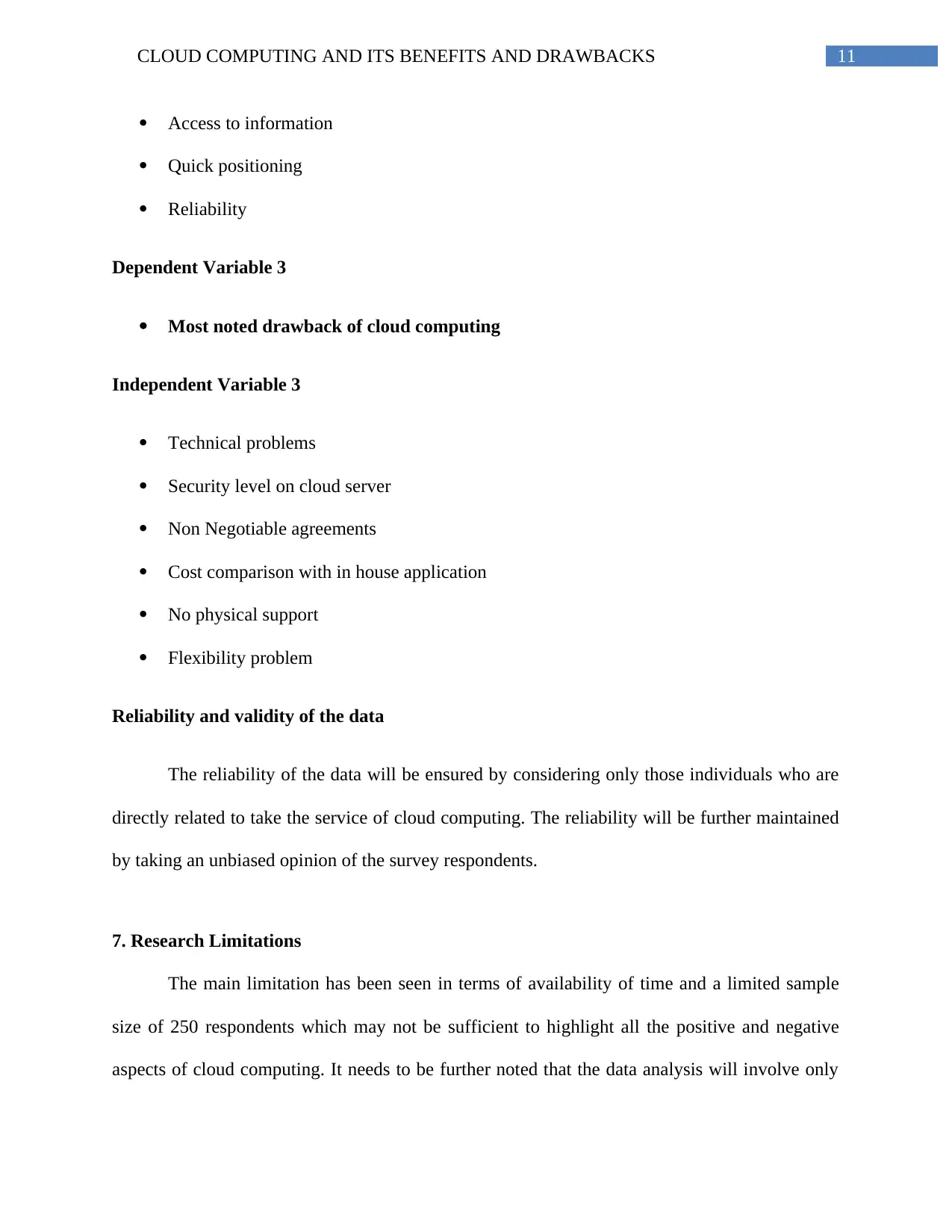
11CLOUD COMPUTING AND ITS BENEFITS AND DRAWBACKS
Access to information
Quick positioning
Reliability
Dependent Variable 3
Most noted drawback of cloud computing
Independent Variable 3
Technical problems
Security level on cloud server
Non Negotiable agreements
Cost comparison with in house application
No physical support
Flexibility problem
Reliability and validity of the data
The reliability of the data will be ensured by considering only those individuals who are
directly related to take the service of cloud computing. The reliability will be further maintained
by taking an unbiased opinion of the survey respondents.
7. Research Limitations
The main limitation has been seen in terms of availability of time and a limited sample
size of 250 respondents which may not be sufficient to highlight all the positive and negative
aspects of cloud computing. It needs to be further noted that the data analysis will involve only
Access to information
Quick positioning
Reliability
Dependent Variable 3
Most noted drawback of cloud computing
Independent Variable 3
Technical problems
Security level on cloud server
Non Negotiable agreements
Cost comparison with in house application
No physical support
Flexibility problem
Reliability and validity of the data
The reliability of the data will be ensured by considering only those individuals who are
directly related to take the service of cloud computing. The reliability will be further maintained
by taking an unbiased opinion of the survey respondents.
7. Research Limitations
The main limitation has been seen in terms of availability of time and a limited sample
size of 250 respondents which may not be sufficient to highlight all the positive and negative
aspects of cloud computing. It needs to be further noted that the data analysis will involve only
⊘ This is a preview!⊘
Do you want full access?
Subscribe today to unlock all pages.

Trusted by 1+ million students worldwide
1 out of 16
Related Documents
Your All-in-One AI-Powered Toolkit for Academic Success.
+13062052269
info@desklib.com
Available 24*7 on WhatsApp / Email
![[object Object]](/_next/static/media/star-bottom.7253800d.svg)
Unlock your academic potential
Copyright © 2020–2025 A2Z Services. All Rights Reserved. Developed and managed by ZUCOL.





